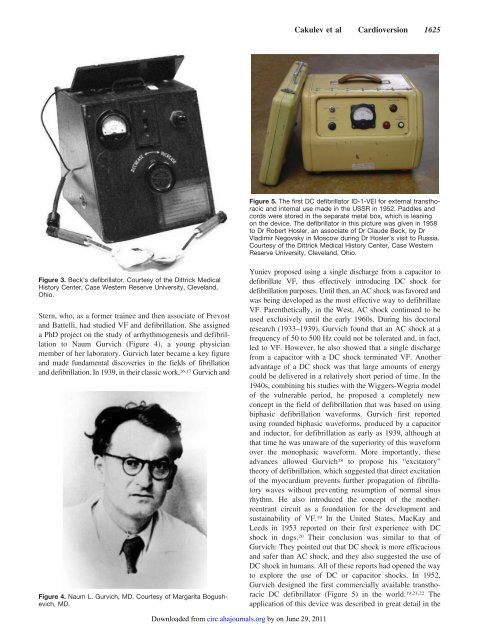Cardioversion Past, Present, and Future - the Laboratory of Igor Efimov
Cardioversion Past, Present, and Future - the Laboratory of Igor Efimov
Cardioversion Past, Present, and Future - the Laboratory of Igor Efimov
You also want an ePaper? Increase the reach of your titles
YUMPU automatically turns print PDFs into web optimized ePapers that Google loves.
Cakulev et al <strong>Cardioversion</strong> 1625Figure 5. The first DC defibrillator ID-1-VEI for external transthoracic<strong>and</strong> internal use made in <strong>the</strong> USSR in 1952. Paddles <strong>and</strong>cords were stored in <strong>the</strong> separate metal box, which is leaningon <strong>the</strong> device. The defibrillator in this picture was given in 1958to Dr Robert Hosler, an associate <strong>of</strong> Dr Claude Beck, by DrVladimir Negovsky in Moscow during Dr Hosler’s visit to Russia.Courtesy <strong>of</strong> <strong>the</strong> Dittrick Medical History Center, Case WesternReserve University, Clevel<strong>and</strong>, Ohio.Figure 3. Beck’s defibrillator. Courtesy <strong>of</strong> <strong>the</strong> Dittrick MedicalHistory Center, Case Western Reserve University, Clevel<strong>and</strong>,Ohio.Stern, who, as a former trainee <strong>and</strong> <strong>the</strong>n associate <strong>of</strong> Prevost<strong>and</strong> Battelli, had studied VF <strong>and</strong> defibrillation. She assigneda PhD project on <strong>the</strong> study <strong>of</strong> arrhythmogenesis <strong>and</strong> defibrillationto Naum Gurvich (Figure 4), a young physicianmember <strong>of</strong> her laboratory. Gurvich later became a key figure<strong>and</strong> made fundamental discoveries in <strong>the</strong> fields <strong>of</strong> fibrillation<strong>and</strong> defibrillation. In 1939, in <strong>the</strong>ir classic work, 16,17 Gurvich <strong>and</strong>Figure 4. Naum L. Gurvich, MD. Courtesy <strong>of</strong> Margarita Bogushevich,MD.Yuniev proposed using a single discharge from a capacitor todefibrillate VF, thus effectively introducing DC shock fordefibrillation purposes. Until <strong>the</strong>n, an AC shock was favored <strong>and</strong>was being developed as <strong>the</strong> most effective way to defibrillateVF. Paren<strong>the</strong>tically, in <strong>the</strong> West, AC shock continued to beused exclusively until <strong>the</strong> early 1960s. During his doctoralresearch (1933–1939), Gurvich found that an AC shock at afrequency <strong>of</strong> 50 to 500 Hz could not be tolerated <strong>and</strong>, in fact,led to VF. However, he also showed that a single dischargefrom a capacitor with a DC shock terminated VF. Ano<strong>the</strong>radvantage <strong>of</strong> a DC shock was that large amounts <strong>of</strong> energycould be delivered in a relatively short period <strong>of</strong> time. In <strong>the</strong>1940s, combining his studies with <strong>the</strong> Wiggers-Wegria model<strong>of</strong> <strong>the</strong> vulnerable period, he proposed a completely newconcept in <strong>the</strong> field <strong>of</strong> defibrillation that was based on usingbiphasic defibrillation waveforms. Gurvich first reportedusing rounded biphasic waveforms, produced by a capacitor<strong>and</strong> inductor, for defibrillation as early as 1939, although atthat time he was unaware <strong>of</strong> <strong>the</strong> superiority <strong>of</strong> this waveformover <strong>the</strong> monophasic waveform. More importantly, <strong>the</strong>seadvances allowed Gurvich 18 to propose his “excitatory”<strong>the</strong>ory <strong>of</strong> defibrillation, which suggested that direct excitation<strong>of</strong> <strong>the</strong> myocardium prevents fur<strong>the</strong>r propagation <strong>of</strong> fibrillatorywaves without preventing resumption <strong>of</strong> normal sinusrhythm. He also introduced <strong>the</strong> concept <strong>of</strong> <strong>the</strong> mo<strong>the</strong>rreentrantcircuit as a foundation for <strong>the</strong> development <strong>and</strong>sustainability <strong>of</strong> VF. 19 In <strong>the</strong> United States, MacKay <strong>and</strong>Leeds in 1953 reported on <strong>the</strong>ir first experience with DCshock in dogs. 20 Their conclusion was similar to that <strong>of</strong>Gurvich: They pointed out that DC shock is more efficacious<strong>and</strong> safer than AC shock, <strong>and</strong> <strong>the</strong>y also suggested <strong>the</strong> use <strong>of</strong>DC shock in humans. All <strong>of</strong> <strong>the</strong>se reports had opened <strong>the</strong> wayto explore <strong>the</strong> use <strong>of</strong> DC or capacitor shocks. In 1952,Gurvich designed <strong>the</strong> first commercially available transthoracicDC defibrillator (Figure 5) in <strong>the</strong> world. 19,21,22 Theapplication <strong>of</strong> this device was described in great detail in <strong>the</strong>Downloaded from circ.ahajournals.org by on June 29, 2011



